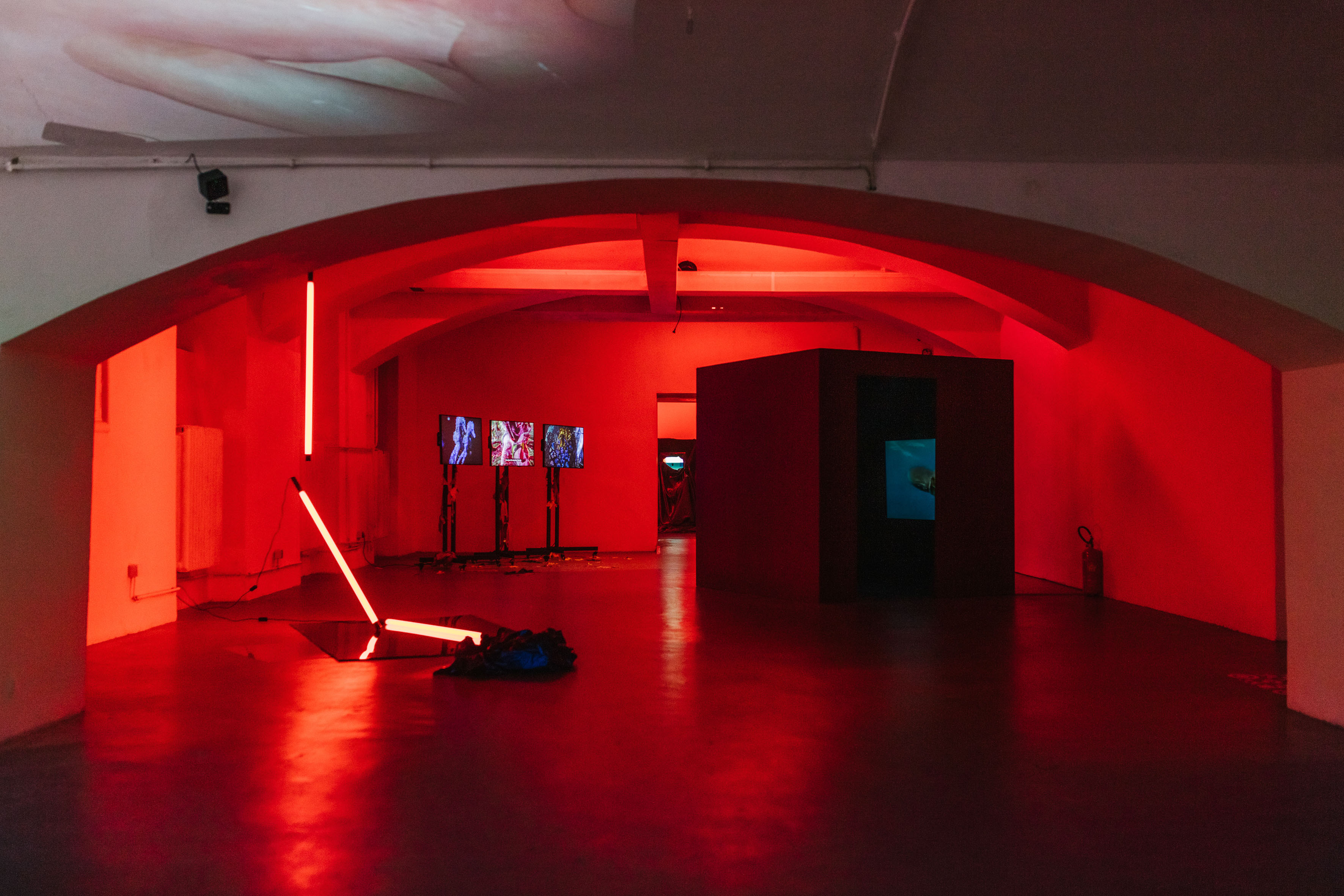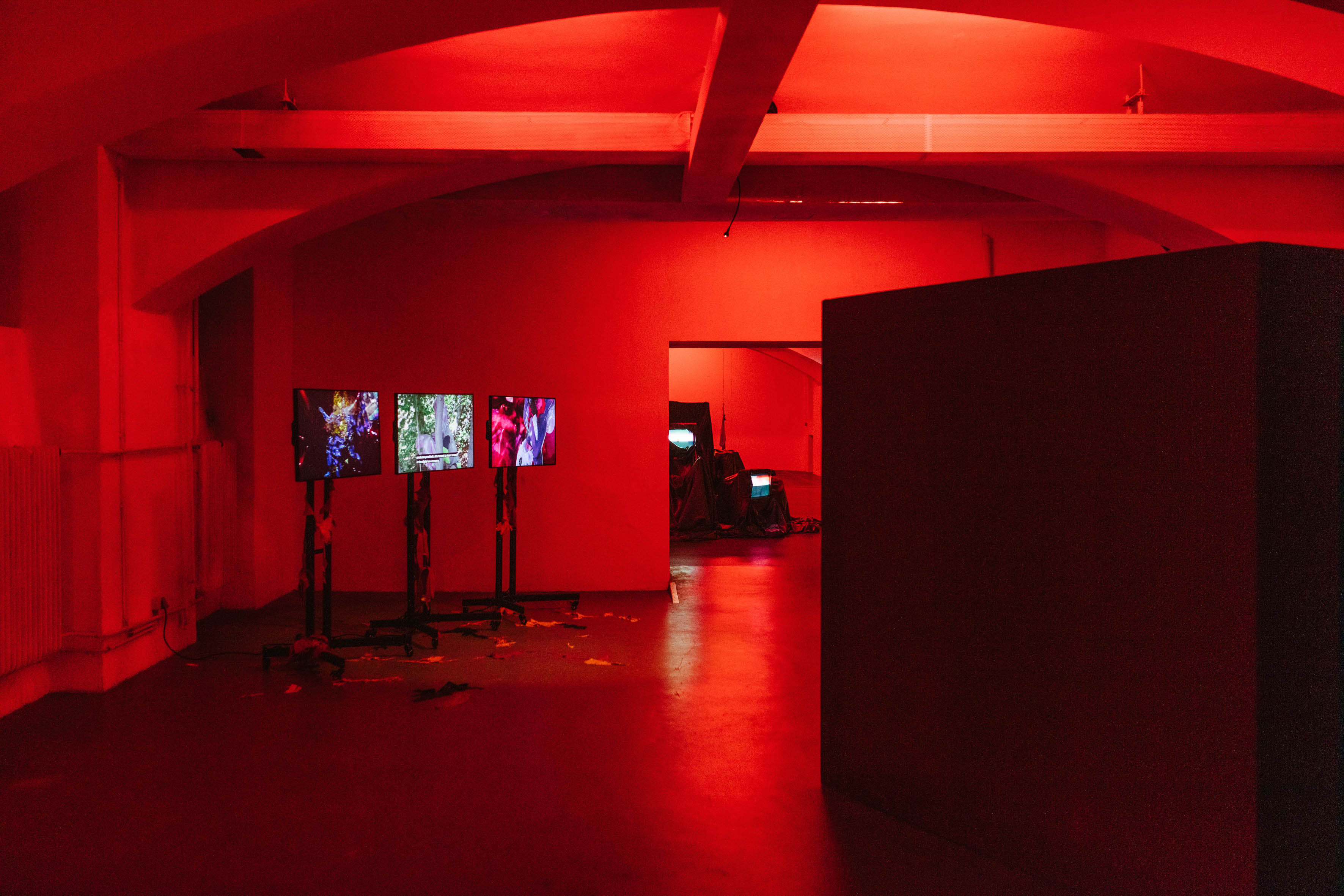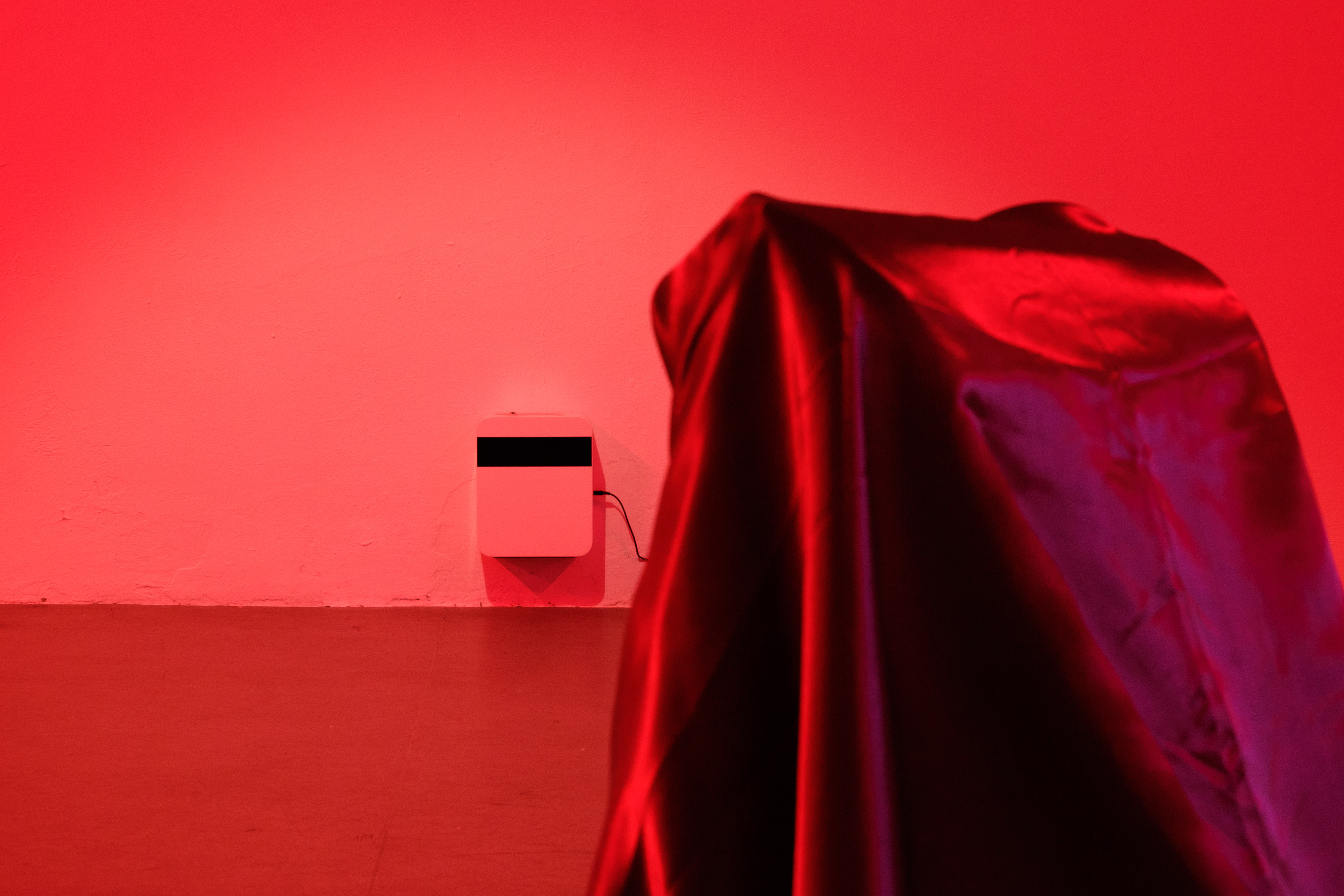YYYYMMDD >>> BACK HOME <<< >>> SELECTED FEATURES <<< >>> HIDDEN ARCHIVE <<<
[20220121]
CONNECTIONS UNPLUGGED, BODIES REWIRED with works by JOHANNA BRUCKNER, DEBBY FRIDAY, DANIELA GRABOSCH, ANNA THOMAS, RINDON JOHNSON, SARA LANNER, MARTINA MENEGON, HYEJI NAM, DAVINIA-ANN ROBINSON and NINGLI ZHU at DAS WEISSE HAUS curated by FREDERIKE SPERLING [from 20211110 to 20220205]
[Photos: Theresa Wey]



















[Curatorial Statement]
Beaten paths. Crowded stability. Silent potentials unborn.
Relations buried. Stranded –– dwelling in forgotten time.
Abandoned and out of sight ––,
bodies rise!
Climbing the cracks and folds of codes and syntax.
Against the backdrop of surveillance capitalism and its intensifying algorithmic navigation of our bodies and relations, the group exhibition “connections unplugged, bodies rewired” speculates on the deviant potential of post-digital intimacies and corporeality in a regimented future.
“You may also like...” or “people you may know...” are familiar phrases to anyone who has ever shopped, streamed a movie, ordered food online or simply is on social media (like 4.48 billion other users worldwide). While following and extracting each of our online movements, technology giants like Google, Facebook (Metaverse) or WeChat have learned to predict our dreams, our desires and our vulnerabilities. With their homophilic algorithms, which are coded to connect what is similar, they have started to infiltrate our social realities, to manage our webs of relations, our corporeal selves. They are trained to orientate us.
How to reclaim agency over who we connect, conspire, become intimate with? What is needed to become ungraspable or even useless for codification? How to keep our inner most secrets and fantasies ours? The performative group-exhibition “connections unplugged, bodies rewired” delves into the debris of combed out data, flirts with the dissimilitudes and incongruencies that the gendered and racialized algorithm has not been able to allocate. It makes room for off-script relations, illegible bodies and ambiguous desires.
Celebrating disorientation and uncertainty as prerequisites for a future self-determination, “connections unplugged, bodies rewired” forces you into a dense assemblage of smells, sounds, images and movements. The artists invited variously speculate on post-digital intimacies and celebrate corporeality as means to collectively conjure a social otherwise. They craft worlds in which community and mutuality are nurtured and enriched by difference rather than sameness.
The physical part of the exhibition takes up elements of club culture to celebrate night life as a breeding ground for intimate, non-scripted and chaotic forms of togetherness. Parallely, das weisse haus’ new post- digital platform dwhX features more contribution.
[1] Johanna Bruckner, “Crushpad Climax”, 2021
HD/4K 3-channel-video installation, 12 min.
“Crushpad Climax“ is a collage of Dark Room Sci-Fi, queer post- pornography and extra-terrestrial social bonding. Aggregating net porn data crumbs into bodies of transition and proposing conditions of trans- corporeal experiences, Johanna Bruckner speculates on the agency of digital failure under “dataveillance”. In so doing, she disrupts pre-defined algorithmic encounters and constitutes a speculative realm for illogical, ungraspable intimacies and desires.
[2] Johanna Bruckner, “Hypermorphisms”, 2021
Installation, variously-colored silicone
Reminiscent of materials used in AI-based post-pornography, variously- sized scraps of silicone infest the technology at das weisse haus. Embodying the waste of net porn data, Johanna Bruckner traces their transitional journey from the debris of virtual data towards abstract corporealities beyond human limits.
[3] Debby Friday, “VOW”, 2021
Audio-visual installation, upper floor January-February 2022
Bringing together aspects of theatre, radio, machine learning, generative art, sound art and electronic music production, the immersive audio- visual play “VOW” features an ever-morphing visual developed with the use of generative adversarial networks (GANs) and sound. Taking place in a futuristic world of planet raves and virtual living, “VOW” explores speculative relationships and the intimacies between us and our future virtual selves, asking what happens to our consciousness once we’ve entirely dissolved into data: “How can you feel with no body?” Find out yourself as of January 2022. Meanwhile, read Debby Friday’s essay “Together, Always Together: On the Erotic Potential of Electronic Punk Music” on www.dwhX.space.
[4] Daniela Grabosch, “AND THEN – I ENTER(ED) THE DEEPEST, MOST DEEP DUG CAVE”, 2019
Reflective fabric, 3D print, clothes hanger, metal chain, scent, QR code, virtual 3D model, sound
Daniela Grabosch’s multi-part installation engages with the materiality of post-digital intimacy, its potential textures and topographies; wearable and reflective fabrics generate an image of it being a malleable and fugitive entity. Navigating the liminal spaces between 3D scanning, analog sensuality and virtual sound, this work manifests as an itinerant conglomeration of smells, finger prints and reflections. While initially conceived as a site-specific response to the Grotto at Galeria Quadrado Azul in Lisbon, Portugal, it will carry das weisse haus’ imprints with it to future venues.
[5] Daniela Grabosch + Anna Thomas, “The screen is where we met —”, 2021
Scent, commissioned by das weisse haus, available as edition via das weisse haus.
Reflecting on online dating apps and other digital channels of getting attracted to someone today, Daniela Grabosch has created a scent in collaboration with scent chemist Anna Thomas, speculating on how post- digital intimacy might smell like. While scientists have shown that information from olfactory nerves fundamentally factor in the decision whether or not to get involved with someone, we can only smell ourselves while getting visually and/or intellectually attracted to someone online. Responding to this narcistic pre-condition, Daniela Grabosch and Anna Thomas bewitch your senses and desires with their secret constellation of aromas. If you need more of it, we have editions ready for you. Meet us at the bar...
Find the conceptual text for the scent here >>> www.dwhx.space
[6] Rindon Johnson, “I First You (11/11)”, 2018
Video, 5:28 min.
Set within a glass island inhabited by little monuments in a placid, hilly sea, “I First You (11/11)” looks at intimacy as an intrinsically ambivalent, potentially painful and melancholic perception. Revealing its proximities to violence, Rindon Johnson navigates different modes of intimacy in relation to sexuality, family and friendship. Ultimately, he asks, how are we supposed to feel good, to enjoy closeness to others while colonial histories, police violence and discrimination are inscribed in our everyday environments and tend to dominate the emtional household of especially Black people and People of Colour?
[7] Sara Lanner, “Intimate Illusions”, 2021
Performance, commissioned by das weisse haus
“Intimate Illusions” is a performative and poetic study on the effects of digitality on our somatic and kinesthetic sense of self. The shiny and slick surface of a piece of sheet metal, one of the most fundamental forms used in metal working, becomes the performer’s main partner in this choreography. Illuminating and reflecting on what surrounds us it leaves us with a flickering memory of shadowy images, bodies and landscapes. Acting as a mirror, agent, partner, desired tool or weapon but also as a space and place it tries to describe the multiplicities of post- digital corporealities in which we find and redefine ourselves - often within the split of a second.
[8] Martina Menegon, “keep in touch”, 2019-2021
VR Experience, Virtual/AR Sculpture, also on www.dwhX.space, sound by Alexander Martinz
How are we “in touch” with others, today? In a world where togetherness is increasingly facilitated through shared platforms rather than geographies, how to feel close to someone? Reflecting on questions like these, Martina Menegon zooms into the changing function of hands – a part of our bodies that used to enable us to gesticulate, to grip, to touch, in short, to participate in the world. Letting a group of wet and distorted hands float and bounce around us, Martina Menegon creates an uncanny and highly perceivable experience.
[9] Hyeji Nam, “Fly like a worm, sing like a snail - however they left, with the rattling sound of the bones breaking down”, 2021
Multi-media installation and performance (with Anna Mutschlechner- Dean, Boeser Reupel, mirabella paidamwoyo dziruni, Hyeji Nam)
Dwelling on the liminal space between word and perception, Hyeji Nam’s multi-faceted work explores the conditions for sensing and engaging with the world. Unfolding in video, text, qr-code, photography and performance, Hyeji Nam’s installation traces the contours of perceived intimacy with one’s own body and proposes a speculative vocabulary for an embodied, poetic language of intimacy. Hyeji Nam’s accompanying poem is also available on www.dwhx.space.
[10] Davinia-Ann Robinson, “whose flesh you are”, 2021
Soundscape, online www.dwhx.space, 47:08 min.
“whose flesh you are” is constituted by an evolving text and a soundscape developed from a site-specific installation of the same name. Working with impressions and manipulations of the artist’s body onto beds of gathered clay, the work examines the process of extraction that her body of color and natural resources experience in colonial nature environments. Tactile engagements between Davinia-Ann Robinson’s body and clay in the installation evoked moments of restoration and repair from colonial trauma,with thetext and soundscape examining intimate moments of corporeal connections to land and moments of disabled presence experienced through colonial violence.
[11] Ningli Zhu, “face to face”, 2019
Video essay, 07:30 min. online, www.dwhx.space
“Face to face” is a self-reflective video essay in which the artist, presented as a cyborg, elaborates on her fascination with the potentials of digital identity in relation to her social anxieties and struggles with self- presentation. Conceiving of the digital as a realm for self-determination, Ningli Zhu draws her viewers into a poetic and fictional visual story, ultimately raising questions on the relationship between her analog and her digital self, herself and the machine.
[Text: Frederike Sperling]
©YYYYMMDD 2021 All content and design by Daniela Grabosch + Ricardo Almeida Roque unless otherwise stated. Images, Videos and Texts can only be used under permission of the author(s).